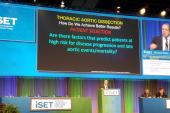ACE Inhibitors/ARBs Appear On Par With Beta-blockers After Aortic Dissection
However, the lack of information on BP control hampers conclusions about comparative long-term effects, Kim Eagle says.

Over the long term, patients who survive an aortic dissection appear to do just as well treated with either beta-blockers or ACE inhibitors/ARBs rather than other antihypertensive drugs, a retrospective analysis suggests.
Compared with other drug classes, beta-blockers and ACE inhibitors/ARBs each were associated with lower risks of all-cause hospital readmission and all-cause mortality over a span of up to 12 years, according to researchers led by Shao-Wei Chen, MD, PhD (Linkou Medical Center, Chang Gung University, Taoyuan City, Taiwan).
There were no differences for any outcomes—which also included death due to aortic aneurysm or dissection, later aortic operation, major adverse cardiac and cerebrovascular events, and new-onset dialysis—when those two medication groups were compared with each other.
“These data provide evidence that ACE inhibitor and ARB therapies may be alternatives to beta-blocker use for the long-term treatment of aortic dissection,” Chen et al conclude in their paper, which was published online this week in JAMA Network Open.
But Kim Eagle, MD (University of Michigan, Ann Arbor), who was not involved in the study, pointed to a major limitation, which was also acknowledged by the investigators: the lack of information on BP control. “That then represents a real challenge in terms of trying to make inferences about types of antihypertensive therapy being better or worse in patients who survive an aortic dissection,” he said. “I think most experts think that the most important thing after a patient has a dissection is that you control the blood pressure in whatever manner you need to.”
There are theoretical advantages to using both classes of agents, Eagle said, noting that beta-blockers reduce the force of the contraction of the heart and might reduce sheer stress on the aorta, and that ACE inhibitors/ARBs might improve the elasticity of the aortic wall. In general, beta-blockers are less effective at lowering BP compared with ACE inhibitors/ARBs, he added.
“Many of us will try to get our patients who survive a dissection on both therapies because they probably have complementary effects,” Eagle said, pointing out that controlling heart rate is an important goal of therapy as well.
Lack of Long-term Randomized Data
International guidelines recommend using beta-blockers for the treatment of acute aortic dissection. But there is some evidence implicating the renin-angiotensin system in the development of aortic aneurysms, and limited animal and clinical studies suggest that ACE inhibitors/ARBs may be beneficial in this setting. A randomized trial in patients with Marfan syndrome, which can involve aortic dilation, showed that the ARB irbesartan decreased aortic expansion, for instance.
No randomized trials have compared long-term treatment with beta-blockers, ACE inhibitors/ARBs, and other antihypertensive agents after aortic dissection, however.
Here, the investigators performed a retrospective study using data from the National Health Insurance Research Database in Taiwan. The analysis included 6,978 adults with a first-ever aortic dissection between 2001 and 2013 who survived to hospital discharge and received a prescription for at least one antihypertensive agent within the first 90 days—3,492 received a beta-blocker, 1,729 received an ACE inhibitor/ARB, and 1,757 received another antihypertensive drug.
After adjustment for multiple propensity scores to eliminate differences in patient characteristics, there were no differences in long-term outcomes between the beta-blocker and ACE inhibitor/ARB groups. Compared with patients taking other antihypertensive drug classes, risk of all-cause mortality was lower in patients taking either beta-blockers (HR 0.82; 95% CI 0.73-0.91) or ACE inhibitors/ARBs (HR 0.79; 95% CI 0.71-0.89).
When comparing the ACE inhibitor and ARB groups, mortality risk was lower in patients treated with ARBs (31.8% vs 51.0%; HR 0.85; 95% CI 0.76-0.95), with a nonsignificant trend toward less death due to aortic dissection or aneurysm (6.8% vs 11.5%; subdistribution HR 0.81; 95% CI 0.64-1.03).
Low Rate of Aorta-Related Death
Chen et al acknowledge some limitations, including the lack of details regarding imaging findings, reasons why patients were treated with certain agents, BP levels achieved, and antihypertensive drug doses.
If we have patients on effective therapy, the likelihood of an aorta-related problem causing death is pretty low. And that’s good news. Kim Eagle
“Despite these limitations, we believe that this study provides results beneficial for clinicians selecting drugs for long-term treatment of aortic dissection,” they write.
Eagle stressed, however, that the researchers are “trying to make the argument that these two classes of antihypertensives are potentially equivalent in aortic dissection survivors, and I think it’s very hard to stretch observational data in that type of direction without knowing what the level of blood pressure control was.”
The most impressive finding for Eagle was the roughly 12% rate of death due to aortic dissection or aneurysm at 12 years (or 1% per year), especially when put into the context of the rate of mortality for acute dissection in the hospital—about 1% per hour during the first 12 hours. That long-term survival rate “is really quite outstanding,” he said, and “does show us that if we have patients on effective therapy, the likelihood of an aorta-related problem causing death is pretty low. And that’s good news.”
Todd Neale is the Associate News Editor for TCTMD and a Senior Medical Journalist. He got his start in journalism at …
Read Full BioSources
Chen S-W, Chan Y-H, Lin C-P, et al. Association of long-term use of antihypertensive medications with late outcomes among patients with aortic dissection. JAMA Netw Open. 2021;4:e210469.
Disclosures
- The study was supported by grants from the Chang Gung Medical Research Project and the Ministry of Science and Technology, Taiwan.
- Chen reports no relevant conflicts of interest.



Comments